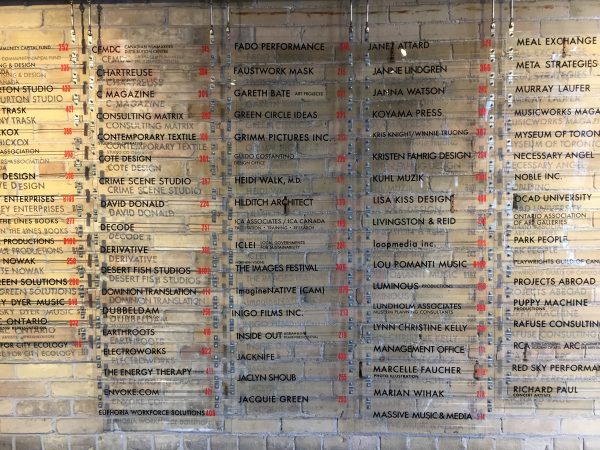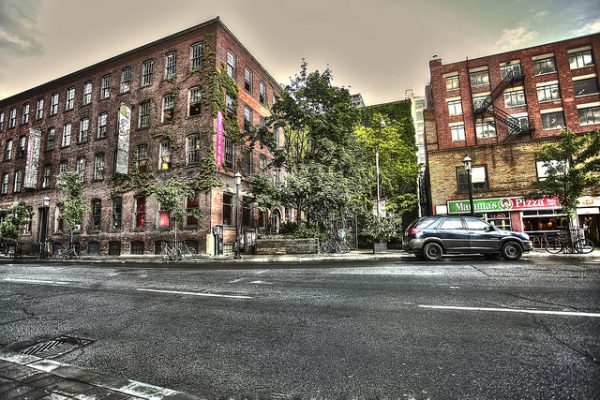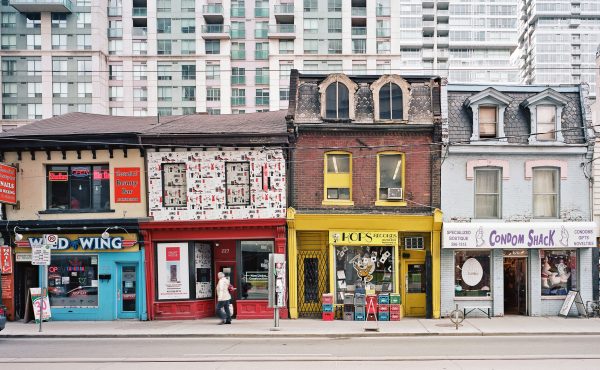I loved 401 Richmond before I even knew what it was.
It was 9 years ago and I was in Toronto, visiting from Vancouver. My friend Lauren, a curatorial student, took me out to a party. We pulled up to a large warehouse building with warm, glowing windows in the night. Inside was a packed gallery. We grabbed drinks and wound our way through people, books, and art. It felt like magic. Where am I, I thought, dazed.
Turns out I was in a building that would become, when I moved to Toronto in 2010, one of the centres of gravity around which my life in Toronto revolved.
But 401 Richmond, managed by Urbanspace as a downtown haven for culture, arts, environmental, and city building non-profits, is under threat because of a tax assessment system that essentially says it should be a condo—not a building filled with hundreds of creative jobs—and taxed as such. Its property taxes are set to nearly triple by 2020.
My second introduction to 401 Richmond was when I moved to Toronto. Looking for jobs, and armed with previous bookstore experience, I applied to all the bookstores I could find. Swipe, a bookstore of design and architecture, was the one that called back. It was located, as it still is today, inside 401 Richmond. I worked in that store—at the time a glass box nestled within the core of the building— for a year while I went to the University of Toronto for my masters degree.
I got an internship at Spacing Magazine, the urbanism magazine that at the time ran its shop out of a space on Spadina. That internship, nearly seven years ago now, was an important introduction to Toronto’s flourishing city nerds scene. I still write for the magazine today, but now Spacing, and the retail store of cool Toronto merch it birthed is housed–you guessed it–in 401 Richmond.
And for the last three years, I’ve walked through the doors of 401 Richmond every weekday for my current job at the charity Park People. We are located in the shared office called the City Builders Lab, which also houses groups like the Ryerson City Building Institute and Diasporic Genius, a non-profit that uses music and storytelling in place-making.
Working here, in a building that has such a concentration of amazing organizations, is not only an inspiring dream, but a practical help. Other organizations we’ve worked with, like Myseum, are just a few flights of stairs away. When we printed out vinyl and poster boards for an exhibit, we walked upstairs to the printing house in the building. When I feel stressed, I visit the rooftop garden or walk around the maze of hallways sometimes encountering a train of small children being led by a worker in the building’s daycare.
401 Richmond is like a drop of water that, when you look closely, contains a million worlds.

The thought of losing the building or of organizations being pushed out because of a tax system that operates on a cruel, cold mechanism privileging blind market-drive growth doesn’t just make me profoundly sad, it makes me super pissed.
Do we want to build a city, with all the complications, messiness, and diversity that word contains, or do we want to build a collection of clean, smooth condos? Do we want to keep space for creative industries, non-profit start-ups, indie art galleries, and environmental groups? Our municipal policies may say yes, but the economic priority in our tax system—rules which are set by the Province—says nope.
That’s because properties are assessed under something called “highest and best use,” which takes a look at the building, what’s around it, and assesses its value on what it could become (a condo) not what it is currently. Highest and best use is one of those fun capitalist words that shrouds itself in a benign objectivity, but really is making a value judgement, nudging our city towards a certain outcome: sameness.
As Edward Keenan pointed out in the Toronto Star, sometimes this could be good—encouraging owners who are holding onto parking lots and under-used buildings to develop them into something more beneficial to the neighbourhood. But its twisted side effect is that by painting everything with the same, broad brush, we wipe out the particularities and difference that can make a neighbourhood great in the first place. Turns out highest and best use can actually be a race to the bottom disguised as a rush to the top.
401 Richmond is not just a building. It’s a hub of community, a place that gives young people their first start, that provides a foothold for fledgling non-profits and arts organizations that do amazing, life-changing work. Without 401 Richmond, my trajectory in Toronto would look vastly different and I’m grateful to Margie and all the Urbanspace staff who make this place work year after year. I hope that it goes on to live a long life, offering the same inspiration, support, and community for many more young people.
If that’s not a highest and best use, then I don’t know what is.
title image by Nino Debassige from Flickr CC





18 comments
The Assessment Act, R.S.O. 1990, c. A.31
https://www.ontario.ca/laws/statute/90a31#BK8
lists a number of possible exemptions or reductions if the press and/or the City makes enough of an issue about this. The more I dig on the situation, the more problematic it becomes, but suffice to say the City of Toronto, if they pass a zoning category and use stating that the building is to be used for what it is currently, then the assessment must reflect that.
Still digging on this…the Act as written, is very convoluted, and it’s not fully clear as to whom is accountable for it. I’d guess the Minister of Finance, but that competence has been removed by making it an arm’s length organization.
Questions are definitely going to be asked about this…
Highest and Best is a relatively new development. It did not first appear with MVA. My suspicion is that it was implemented to bridge the growing gap between the residential and non-residential assesment base. Without it, and in conjunction with fixed ratios between classes, Toronto’s pampered residential class would have had to endure property tax increases greater than the rate of inflation.
Of course, if you are the owner of a large office tower, you are assessed based on rental income. There are even scenarios where smaller properties are assessed on rental income (481 Queen West, IIRC). If any property in Toronto deserves such treatment, it is surely 401 Richmond.
Ha. This is all very touchy feely but ignores reality.
I suspect if the owners were asked to accept a downgraded zoning they would decline.
Have cake, eat too.
Also, if you think this is anything other than a PR move to shift the blame to “the system”, you’re dreaming. Re-development proposal is imminent.
Can we also agree that highest-use affects financing. When re-financing the building, I wonder if the beloved landlords will spread that bonus cash to mitigate the tenant’s CAM. Doubtful.
Always nice to have a troll in the comments section to spew garbage.
Michael obviously knows little about the building (there are no plans to redevelop of the site and there’s no need to refinance since its paid in full ages ago), it’s owners, or the value of a cultural hub. The building is not a parking lot, which is what prompted MPAC to create the designation of “best use” in the tax code.
The value of 401 is vital to a downtown that is losing all sorts of culture. The problem with downtown TO from the 50s to early 90s was how devoid it was of culture. People created a new downtown out of this.
Folks like “Michael” seem to see this owning a building as purely transactional, when 401 Richmond is so much more than that.
Ok. So let’s see if they agree to downgrade the zoning.
My point is that the owners can and do benefit from their zoning.
And I guess a differing opinion is automatically a troll.
You’re trolling because the writer of this piece obviously knows a lot about the building and it’s value, yet you discredit his opinion because of your uninformed assumptions. You use the phrases “I wonder”, “I guess”, and “I suspect” in all of your comments. You clearly admit to not knowing anything about this site or the situation and just lump it in with any other building. As you can see in all of the media articles and coverage on this topic, that 401 Richmond is not just an ordinary building. It’s clear that you don’t know much about progressive city building or the impact of the creative industry in this city.
@Lula “The impact of the creative industry in this city”
You mean all the out of work art kids that flock to this city while living off their parents and government grants?
The “hip” loft parties where people just pop bad ecstacy, snort bad coke and tell each other how great their shitty contemporary art opening was?
Give me a break.
So the writer’s knowledge of the culture relevance of the building, of which I agree, completely overrides the financial argument. I do know this building. I admire this building. I just think the argument being made is too one-sided.
The owners are complaining that the taxes are too high and this is due to their zoning that allows a use greater than it’s current use. Yet they benefit from their zoning in many ways. But no mention of this aspect in the post.
I use “I wonder, I guess and I suspect” as a matter of style to point out there is some hypocrisy going on here. I regret that I didn’t put them all in one comment. What I’m saying is that the owners want it both ways.
By the way, owners re-finance “paid-off” buildings all the time
Wow, Michael. Just wow. You’ve proven my point better than I could’ve that you know nothing about this topic or building. Buh-bye.
Much more detail on the legal and historical aspect can be found here:
https://www.thestar.com/entertainment/visualarts/2016/12/15/401-richmond-arts-haven-facing-huge-tax-hike.html
I had posted an excerpt earlier but had perhaps quoted too much to be published under fair-use doctrine. I’d suggest the likes of Brian and Michael above should acquit themselves with something more than wild, unfounded accusations.
I hope this publication, along with others, follows this story closely. 401 is unique in some aspects, but the trend in Toronto is overwhelming. Good way to banish all real artisans and replace them with plastic imitations.
Latest positive twist reported here:
https://www.thestar.com/news/gta/2016/12/21/how-much-did-401-richmond-st-w-cost.html
Andrea Horwath has made a statement via an open letter to the Legislature on it.
I’m sorry you feel that way.
I wonder if the air rights could be sold to neighboring developments to ensure that this site cannot be redeveloped and thereby reducing the potential future use as defined by mpac. Or maybe write up some restrictive covenants on the deed that restrict future uses and redevelopment.
I’m am surprised that the media has not realized that this is not just a problem for heritage buildings. Insofar as that being an official designation. This is an issue that is effecting thousands of small commercial properties in Toronto. Streets like the Danforth, College, Bloor West, Spadina, etc, etc are full of older smaller properties that are facing this same issue.
First off, “Highest and Best use” is direct result of MVA, another horror from the Harris years, secondly MPAC does not accept local zoning, or even heritage easement agreements into consideration when conducting assessments or assigning valuations. Thirdly, while the province could solve this comprehensively across the Ontario and save and in encourage Heritage protection, the city also has power to split out commercial tax clauses and assign lower tax bands to commercial property.
Adam is correct regarding the city’s ability to create a seperate tax class. The only problem is that the burden will fall on the other properties in the non-residential class.
In the end, Toronto could go a long way to solving it’s financing needs if it would just raise its residential rates to something approaching what would be required to cover the services received.